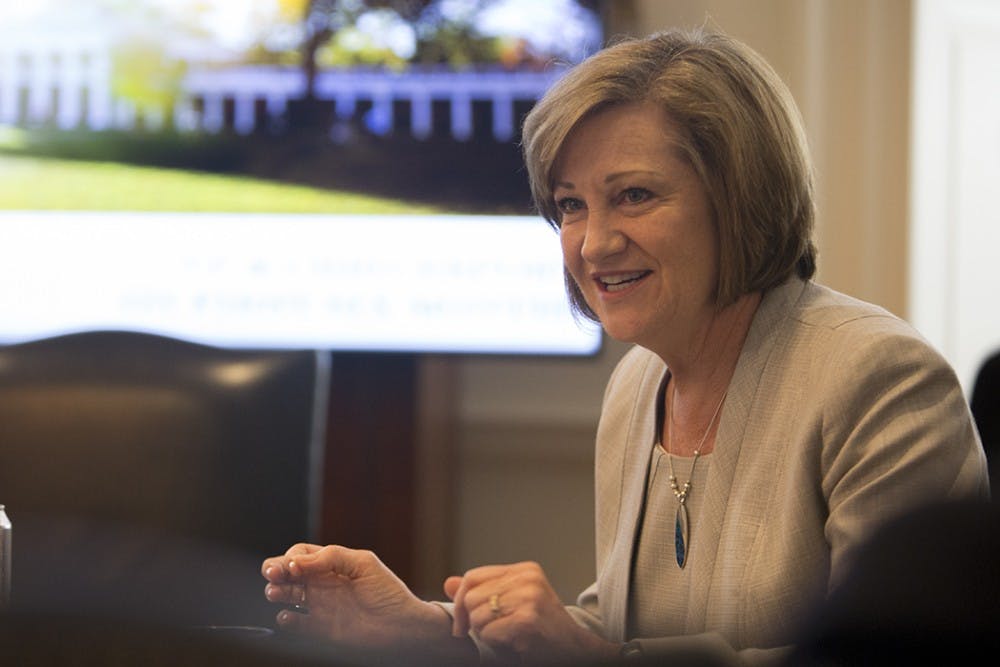The Board of Visitors Finance Committee met Friday morning and approved proposals to increase dining contract rates and students, faculty and staff housing rates. The University’s investments, assets, workforce and budget were also discussed.
Based on feedback from the student body, the Board also approved a proposal to add two new meal plans to the current options. The University would offer an 80 and 160 block meal plan, averaging five and 10 meals per week, respectively. This proposal targets upperclassmen living off Grounds and seeks to increase convenience for them.
The meeting began with an assessment of housing rates for students as well as for faculty and staff.
“The University operates 80 units of staff housing,” Senior Vice President for Operations Colette Sheehy said. “[It’s] transitional housing, it’s not meant to be permanent.”
University housing also includes 6,804 beds for students. Approximately 42 percent of undergraduates are housed on Grounds. Last fall, on-Grounds housing had an occupancy of 97 percent.
The proposal states the average rate of double rooms at Virginia public colleges and universities for the 2016-2017 academic school year is $5,813. The comparable average at the University is $5,876.
State policy requires the University to charge rents for faculty and staff housing comparable to market rates for similar properties, Sheehy explained. She then discussed a proposal for a roughly 3.49 percent increase in rates for faculty and staff housing and a 2.8 percent increase for student housing.
According to the proposal, increases in rates for staff and faculty housing are driven in part by efforts to direct the University rental rates toward market rates in compliance with state policy.
When explaining the reasons for increasing student housing rates, Sheehy pointed toward recent projects the University has undertaken that have led to $1.6 million in new debt. Projects include putting air conditioning units into the International Residential College and renovations to the Gooch Dillard dorms and the McCormick Road residence halls.
The discussion then turned to University dining services, focusing on raising dining rates and increasing meal plan options.
The Board approved a proposal to increase meal plans for the 2017-18 academic year by an average of 1.3 percent. According to the proposal, the increases are necessary to cover increases in food, personnel and other related costs.
After a review of the University’s endowment and investments, recently appointed Vice President and Chief of Human Resources Officer Kelley Stuck discussed the demographics and future of the University’s workforce.
“I think what we’re doing with HR here will be a model in higher education,” Stuck said. “It’s critical that we invest in our people.”
Stuck presented visual representations of the generational breakdown of the workforce and charts indicating the future trends in the age representation of those populations in the University workforce.
The average employee age at the University is approximately 45. Thirty percent of workers are millennials between the ages of 22 and 38, 34 percent are from generation X between ages 38 and 53 and 35 percent are baby boomers between the ages of 53 and 72.
“Baby boomers are moving out of the workforce [and] Generaction X is increasing,” Stuck said. “The millennials, which is the largest group, is growing rapidly.”
Millennials currently occupy 50 percent of the workforce and by 2025 they will account for 75 percent of the workforce. Stuck stressed how the University must adjust to these trends and meet the needs of the changing workforce. The workforce is increasingly diversifying, not only generationally, but also by gender, race and ethnicity, Stuck said.
Stuck ended with an emphasis on creating an exceptional experience for employees at the University. The University already has a strong reputation for providing students with a positive experience, and the same needs to be true for employees, Stuck said.
The meeting closed with a discussion of an increase in salaries for University employees and the University's annual state budget which the Virginia General Assembly recently voted to reduce for the 2017 fiscal year.
The General Assembly voted to increase University employee salaries by two percent for faculty and three percent for staff. Regarding the budget, the University received a net reduction of $5.35 million in base operating support.
The University will have to find ways to compensate for the loss of funding, which several Board members said they do not want to achieve through an increase in tuition.
“Tuition is always the last lever we want to pull,” said Patrick Hogan, the University’s executive vice president and chief operating officer.
Committee Chair James Murray said the Board is still processing the recent budget cuts and proposed a meeting in April to discuss tuition and reductions in funding.







